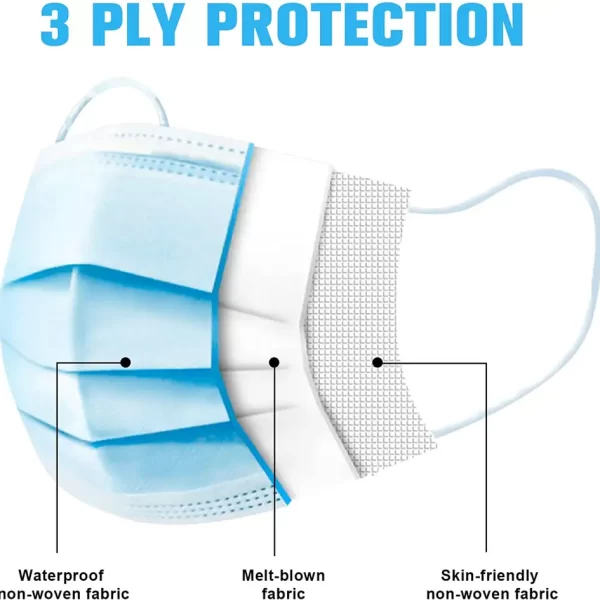The Science Behind 3-Ply Face Masks
Introduction
In the face of global health challenges, the humble face mask has become a mainstay of protection. Among the various types, the 3-ply mask stands out for its blend of simplicity and effectiveness. However, there’s a rich tapestry of science behind this everyday object that often goes unnoticed. In this article, we delve into the in-depth science behind 3-ply face masks.
Understanding the Tri-Layered Approach
The term ‘3-ply’ signifies the presence of three distinct layers, each designed with a specialized function for comprehensive protection. From the outside in, these layers are the hydrophobic layer, the filter layer, and the soft absorbent layer.
The Hydrophobic Layer
This outer layer serves as a barrier against larger airborne particles and liquid droplets. The term ‘hydrophobic’ means water-repelling, and true to its name, this layer constructed from non-woven materials like polypropylene prevents external moisture and droplets from seeping into the mask. This layer is crucial in protecting the wearer from droplets that may contain pathogens.
The Filter Layer
At the core of a 3-ply mask lies its most crucial component, the filter layer. Often made from a specialized material called melt-blown fabric, this layer is the workhorse of the mask. The fabric is produced through a process that creates a non-woven mesh of nano-sized fibers, creating a complex network that traps tiny particles.
This layer capitalizes on the principles of mechanical filtration and electrostatic adsorption. As particles attempt to navigate the tortuous pathways within the filter, they become physically entrapped. Simultaneously, the fibers hold an electrostatic charge, which attracts and holds particles, adding an additional layer of filtration.
The Absorbent Layer
The innermost layer of a 3-ply mask is primarily designed for comfort and maintaining the mask’s overall integrity. This soft, absorbent layer soaks up the moisture from the wearer’s breath, keeping the outer layers dry. This helps to preserve the mask’s structure and prevents the outer hydrophobic layer from becoming damp, which could make it less effective.
Exploring the Efficacy of 3-Ply Face Masks
The tri-layered structure of 3-ply face masks is a testament to their design’s scientific soundness. But how effective are these masks in real-world situations?
A host of research efforts have been conducted to answer this question. One of the most comprehensive reviews, published in The Lancet, examined various studies on face masks’ effectiveness in preventing disease transmission. The review confirmed that face masks, including 3-ply varieties, could reduce the risk of virus transmission by up to 85%.
Understanding the Importance of a Proper Fit
While the science and structure of 3-ply masks are essential to their function, another crucial factor comes into play – the fit of the mask. For a mask to be effective, it must properly seal the area around the nose and mouth, preventing airborne particles from bypassing the mask’s filtration system.
An ill-fitting mask that leaves gaps at the sides can compromise the wearer’s protection. To ensure a snug fit, many 3-ply masks incorporate a flexible nose bridge that can be molded to the wearer’s face shape, and elastic ear loops for adjustable tightness.
Investigating the Sustainability of 3-Ply Masks
The global reliance on face masks has highlighted another crucial consideration – sustainability. Many 3-ply masks are designed for single-use, leading to a significant increase in medical waste. Responding to this, scientists and manufacturers are exploring more sustainable options, such as biodegradable materials or reusable designs that maintain high filtration efficiency even after cleaning.
The Future of 3-Ply Masks: Innovations on the Horizon
As we continue to understand and combat airborne diseases, the science and technology behind 3-ply face masks will undoubtedly continue to evolve. Researchers are investigating new materials and designs to increase filtration efficiency, improve comfort, reduce environmental impact, and even incorporate smart technologies like health monitoring sensors.
Conclusion
The science behind 3-ply face masks unveils a marvel of design and function. Far from being simple barriers, these masks employ intricate principles of physics and material science to offer protection against airborne threats. As we continue to navigate challenging health landscapes, understanding the science behind our protective measures can empower us to use them more effectively and appreciate the complexity of their design. So, the next time you don a 3-ply mask, remember the remarkable science that makes your everyday protection possible.
Please visit our website for more product details https://medposnonwoven.com/product/3-ply-civil-face-mask-with-earloop/

